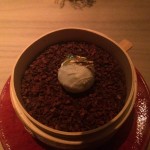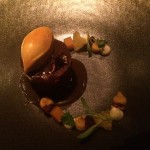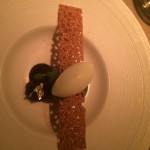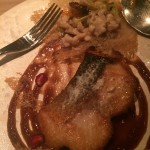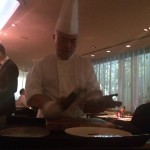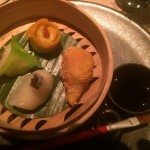HKK, hidden away in the streets behind Liverpool Street station, is a fine dining Chinese restaurant in the same way, say, that the Cinnamon Club is fine dining Indian or Quattro Passi claims to be fine dining Italian (not that I know anyone who has been there), and so on. Defining “fine dining” is in the eye of the beholder, though this version tells us:
“Fine dining restaurants, also referred to as white tablecloth restaurants, are typically higher end and fancier restaurants. As opposed to casual eateries, cafes or family-style restaurants, fine dining caters to an upscale clientele and provides the highest quality of food. A fine dining restaurant has a formal atmosphere, is almost always a sit down restaurant, and has a fancier menu than most restaurants. Fine dining restaurants offer wine lists, and sometimes sommeliers, to help you with your food and wine pairing. They also have dress codes in most cases.”
Given that this fine dining restaurant did not provide linen tablecloths (in fact the table was decidedly plain and ordinary), nor require a dress code (even though we were dressed formally), a black mark and further research to find what separates the wheat from the chaff.
One theatrical example from HKK may help to elucidate the issue: at the end of the evening we were presented to the head chef, and received a copy of our evening menu, stamped by the man himself with his exclusive seal. They certainly don’t do that at your local Chinese takeaway, but the point made is straightforward: you have not simply eaten food but gained a unique gastronomic experience forged from very special ingredients.
This is the sort of joint where you are shown to your table, given a hot towel before you’ve eaten anything, and presented with a drinks menu only, reason being that in the evening you get two choices: 5-course tasting menu or 8-course tasting menu. On closer inspection I actually photographed ten plates of exquisitely presented and minutes composed food, each of which was explained by our waitress in a thick accent I could barely hear. Consequently, each course was a voyage of discovery, referenced later when we had the menu to check back.
Waiters outnumbered diners for much of the evening, though the diners included at least two parties of oriental extraction, one of whom was snapping their grub even more assiduously than I. The reviewing habit is now truly a democratising influence on restaurants.
As we were presented first with drinks menus, this seems a fair place to start. There were two: a pricy cocktails menu, often the preserve of “bar & grill” establishments rather than high-end oriental restaurants; the second was a wide-ranging wine list, including a fair number of exclusive bottles. I selected an impressively fresh, floral and aromatic Pinot Blanc (full description in the menu pictured above.) Whether it was the perfect accompaniment to our food is a different question, though there was indeed the option for wine pairing. The wine chosen did not drown out the delicate flavours of several courses, but did please both recipients.
Meanwhile, the food began to arrive in small but delightful and decorative plates:
Duke of Berkshire pork belly manta: imagine a slice of perfectly braised belly pork in a sticky jus served as finger food within a miniature Yorkshire pudding. Delectable.
Chrysanthemum supreme seafood soup: a delicate chicken broth suspended with prawn meat and topped with a spoonful of chrysanthemum leaves (served separately)
Dim sum trilogy: actually a quartet within individual steamers, complete with soy sauce and a paintbrush with which to apply it. One contained lobster and one dover sole topped with some caviar variant. Also a spicier dim sum and a deep fried dim sum – contents not clear from the explanation but undoubtedly delicious.
Roasted cherry wood Peking duck: the cabaret turn. The waitress explained how the Peking duck is prepared, which I know to be a time-consuming process, having done it myself. This duck (sourced from southern Ireland) was beautifully cooked, then carved and served by a chef near out table (there seemed to be a lot of duck he took back with him to the kitchen – I was tempted to ask him to leave it for us to gnaw off the bone!) Said duck arrived on the plate as a sliver of crispy skin, a portion of breast and with a slick of perfect hoi sin sauce, a superior pancake containing leg meat, plus a tiny but tart dressed salad. The flavour of the cherry wood was not evident, though the meat was perfectly and undeniably moist, tender and flavoursome.
Wild seabass, black truffle balsamic vinegar: arrived as a small crisped fillet topped with crisp rice paper and small slivers of sauced fish on top. Truffle appeared in even thinner slivers – though it did also arrive unannounced in other courses, in case we missed it.
Grilled Japanese Wagyu beef, king sansei sauce: the tenderest beef on earth served with Thai garlic, slivers of kumquat, deep fried balls (potato croquette?), hunks of crispy rice, green beans (a test for chopstick technique) and a rich and earthy sauce.
Black sesame cream, sesame tuille, lemon sorbet: more green than black, the cream was topped with a glorious honeycombed tuile and a refreshing sorbet.
Pumpkin cake, five spice, carrot ice cream: we mistook the cake for carrot, but it sat moistly on the plate, topped with a small lozenge of ice cream and surrounded by an arc of spiced accompaniments. Don’t ask me what they were, though one was surely ginger and another possibly grapefruit.
Ginger truffle: arrived in its own bamboo steamer on a bed of minced cocoa beans. Within each truffle sat a small and ice cold smidgen of ginger ice cream.
All in all, a glorious combination, though for the most part only distantly related to the culture from which it is derived, fine dining being a reflection more of the chef and his creative urges. It is the antidote to artisan cookery, though undeniably crafted with minute attention to detail – but then, so it should be for £120 a head, including wine, making it the most expensive yet among the Millward gourmet reviews. My justification to myself is that in the long run you forget the cost but remember the occasion and the company, and in any case it’s certainly possible to buy a bargain and £100 per person and be ripped off for a fiver.
Whether it is worth the money only you can decide, though it work out more than you had budgeted. This is food that has been lavished over – the gourmet equivalent of a pampering at the spa – but was it the best I have eaten? No, almost certainly not. Very good, to be sure, but not the best and most intense flavours – many dainty and delicate dishes but few of which smacked the diner around the chops in sheer awe.
Just as the tasting menu is devised as a perfect combination of Yin and Yang to derive a balance between tastes and textures, so it is with life that for every fine dining experience there are occasions where you want something rough and ready; were this everyday food you would soon grow tired of the fussiness and yearn for egg and chips. At least I have a souvenir though!


